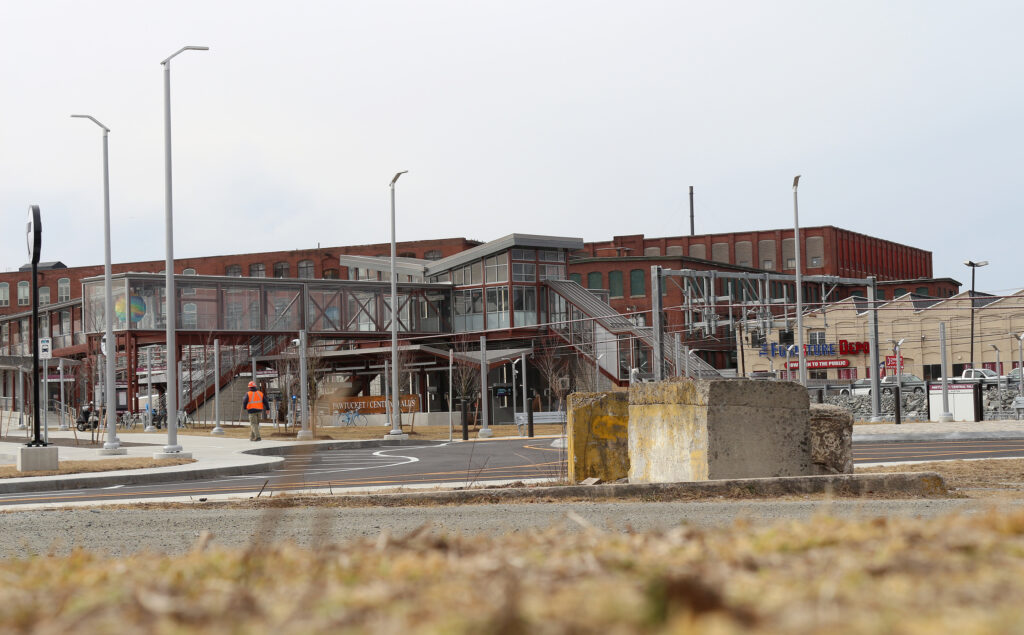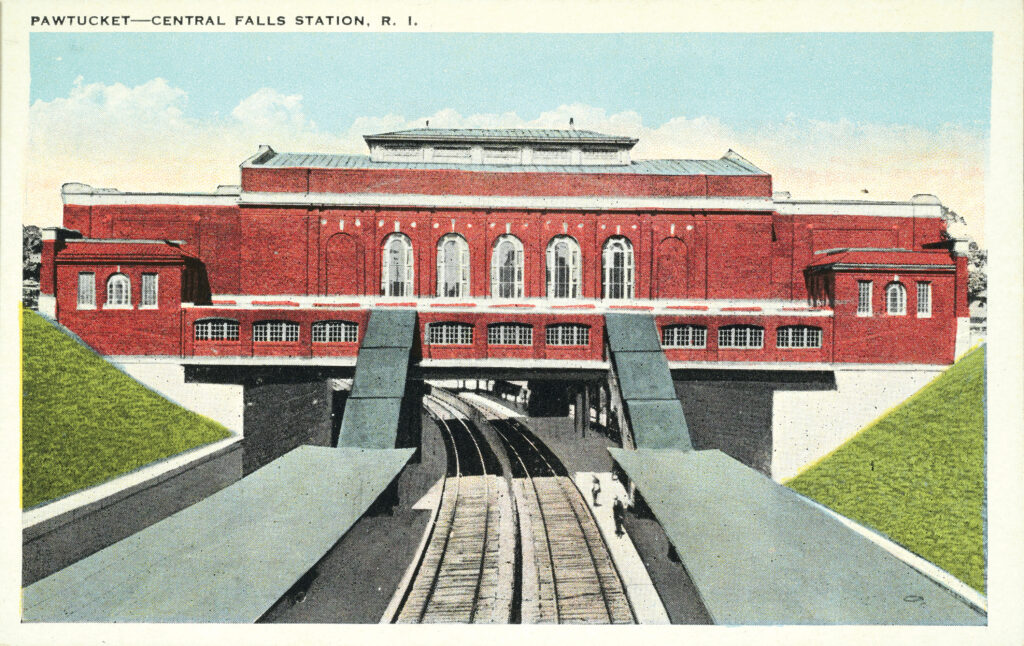
The doors of the bus swooshed open and the strong-eyed man behind the wheel turned his head toward me. We stood suspended in silence, the rain drops beating down the windshield casting a moving shadow across his face. After another second I climbed aboard, beating my soggy newspaper against the cold steel rail. A lightning strike illuminated the inside of the bus and its empty corners. I pulled my trench coat tight across my sweater. “Where ya headin?” He asked in a dry, cigarette-marred voice. I took in his whiskered beard, the scar above his right eye, and the slight droop of his lip; a face that’s taken too many bus rides and still hasn’t reached its destination. A thunderhead boomed above us. The doors swung shut behind me, and under the flickering yellow lights I finally met his stare: “Pawtucket Train Station.”
Ok, this is a bit of an exaggeration. I wish I could say my life played out like the intro of a Dirty Harry flick, but a girl can dream – right? Ol’ reliable RIPTA (I use “reliable” sparingly) picked up my colleague and I outside the Motif office in Pawtucket. As we zipped and zoomed through the tight, swirly streets of downtown, I couldn’t help imagining I was on J.K Rowling’s “Knight Bus,” a mystical, shapeshifting bus that transported witches and wizards throughout the alleyways of a fantastical Great Britain.
As the buildings flew by against the wispy white sky I fantasized about the new station. I figured it would be just like the movies, maybe less gargoyles than Rowling would’ve liked, but at least a platform full of tall, handsome men waiting for their lovers, and floppy-hatted women waving gloved hands to departing cars (dare I mention the train station scene in Casablanca). As someone who just recently found out
she was harboring beliefs fed to them by Hallmark movie plots, I secretly hoped the place would be bursting with the type of people that you “just haven’t met yet” – a life-altering love affair or
a quirky friend. A vessel for all walks of life to accidentally stumble into each other, strengthening the fraying layers of rope that hold the historic mill town of Pawtucket together.
The bus pulled into the roundabout of the station and I looked desperately for something resembling platform 9 and 3 quarters, or at least my Humphrey Bogart look-alike. Framed by abandoned brick buildings, a meat market and a graveyard, the station instead lay desolate. It hugged the track with skeleton arms and hands rising from ancient dirt, connecting between them and settling down as corridors on either side, spindly stairs reaching out like fingers from the hand. There were a few straggling folks sitting down by the bus station sign, a sign that looked haphazardly placed with the nonchalance of someone placing a “wet floor” sign where they just mopped. There were no heartfelt goodbye kisses, jovial conversations, nor overpacked and travel-bruised suitcases. The only movement besides the scuttle of leaves and the flap of bird wings was the orange polyester of worker’s vests through the windows.
What I couldn’t find in this station was the real reflection of Pawtucket. In homage, there is a rainbow glass ball hanging from the ceiling, its intricate blown strings meant to represent the “interwoven strands of today’s commuters;” but it made me feel as untethered as it looked from afar. What I didn’t realize was that the cause for my disillusion lay less than 3 blocks away, the original Pawtucket train station.
On a sunny January day 107 years ago, the first Pawtucket train station opened its doors to an eager public. This was a station fit for Rhett Butler and Scarlett O’Hara; an impressive, gothic style brick building that modeled the prosperity garnered from Pawtucket’s mill revenue in the roaring ’20s. One side lay in Pawtucket, the opposite in Central Falls, and the softly gleaming wooden floors and pew-like benches tied a knot between the two. Beaming down over the bustling Rhode Islanders were cathedral ceilings and ornate light fixtures. A large clock beat punctually over the low hum of waiting strangers sharing coffee and exchanging names. Pawtucket and its people were hopeful. They were part of an emerging city that was enjoying the economic success built from being the first mill town in America, and the beauty of Pawtucket’s train station represented that.

Now more than a century later this station stands vacant, abandoned; the only conversations being had are among ghosts, eerie murmurings mistaken for wind whistle through empty corridors and doors. In the cobwebbed corner a yellow newspaper dated 1959 lays under a cover of dust; its fading headline barely discernible: “Pawtucket Train Station Closed for Good. Falls Into Disrepair and Lack of Funds.”
Like a shiny toy, the new station sits less than a mile away from its decrepit, 20th century counterpart. Since its closure there have been ambitious plans to revitalize the old station, but they kept getting side-lined; in 1972 the property was bought and was supposed to undergo a major redevelopment. This did not happen. In 1984 the train station was going to be memorialized in the National Register of Historic Places. This did not happen. Instead the marbled-floored station was used to house a flea market. In 2004 Senator Reed got 235,000 dollars of funding to study if it could be restored. What this money got Pawtucket was the conclusion that the old station sat on a track that was “too curved” to accommodate modern trains. In 2005 it was deemed entirely unfit for any public enterprise, leaving it to sit there empty as full trains roared by and political chatter switched to the building of a new train station; an endeavor that would cost 43 million dollars of federal funding.
Meanwhile, 3 blocks away from our 43-million-dollar skeleton, the homeless sleep on unvarnished pews, an addict shoots up in the empty barber shop, and graffiti pales over the long-stopped ticking clock.
I wait for the bus to take me away from the modernist nightmare, a reminder, to me, that we have lost the glamor of a bygone era. Instead of putting money into restoring the old train station to the glory it represented, the old and hopeful mill town of early 20th century Pawtucket, we have left it to decay. We bulldoze over the past to create a better future, but there is something to be said about respecting strong foundations. Will the future leave us in the past too?
A man with kind blue eyes sat next to me. He tells me a joke and he laughes a toothless grin. As the bus drives us through the late afternoon I ask him what he thinks about the new train station. His eyes somber and he looks straight through me, to the dilapidated mill buildings, the empty parking lots, the silent men and women walking against the wind, “it’s nice and all, but we don’t need that.”
On a Positive Track
Aesthetics aside, the new train station brings convenience and economic promise to the city of Pawtucket. Pawtucket Mayor Donald Grebien noted at the ribbon cutting, “On behalf of the City of Pawtucket, I am thrilled that this day is finally here… This transit hub will open so many doors for both Pawtucket and Central Falls, whether it be new housing units, retail spaces, and beyond – this truly is a tremendous opportunity.”
Governor Dan Mckee emphasized that the new station is, “A major addition to Pawtucket, Central Falls and all of Blackstone Valley, supporting economic development efforts in these communities while providing tremendous transit options for all Rhode Islanders and those visiting our great state.”
And new congressman Seth Magaziner remarked, “The new Pawtucket-Central Falls Transit Center will catalyze economic growth for the entire region. By establishing a new commuter rail stop and enhancing bus service, this station will revitalize the surrounding neighborhoods, reduce air pollution, and make it easier for Rhode Islanders to get to work. I applaud federal, state and local officials who guided this project and the working men and women who have made it a reality.”
Find the new station at 300 Pine St, Pawtucket and on the MBTA website.
